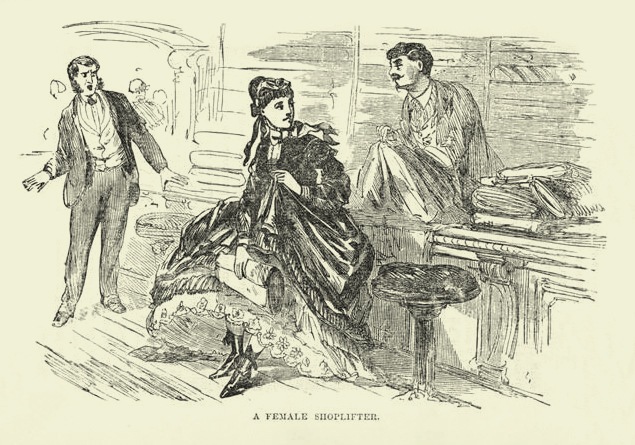
The Forty Elephants Gang
If you think girl gangs are something new, you should know that sisters have been doing it for themselves in the criminal world since Victorian times. The Forty Elephants gang was an all-female organized crime collective active in London’s Elephant and Castle District from at least 1873 right into the 1950’s. They specialized in shoplifting, with some blackmail and extortion thrown in to make them particularly badass. They were also known interchangeably as The Forty Thieves, but I like the pachyderm name better, because elephants are smart, and this group’s most notorious leader, Diamond Annie, wasn’t known by the London police as “the cleverest of thieves” for nothing.
Annie Diamond took over the Forty Elephants gang in 1916 when she was twenty and ran it with an organized and creative precision. She divided the group into cells, sometimes targeting one shop for thieving together or spread out in a calculated formation in order to hit multiple locations at once. Taking advantage of the voluminous dress of the early 20th century, Annie outfitted her crew of light-fingered ladies with specially made coats, skirts, muffs, bloomers and even hats that featured hidden pockets and other compartments for the storage of loot. When her skilled thieves were not terrorizing Selfridges, they were set up as maids using false references, with instructions to rob their employers blind. Seducing the man of the house into sightlessness was also encouraged, thus expanding the Elephant’s coffers through blackmail. A child born into the violent poverty of the Victorian workhouse, Annie defended her gang’s territory and interests with harsh brutality when necessary. Sometimes she would hire outside male muscle from her allies, The Elephant and Castle mob, but Annie was not above taking care of business personally. In keeping with her surname, she wore a cluster of diamonds on her fingers, using them as a glamourous form of brass knuckles. You didn’t want to be on the receiving end of her multi-carat punch.
Second in command was “Baby Face” Maggie Hughes. She stood only 4 foot 11 to Diamond Annie’s towering-for-the-times 5 foot 9, but you didn’t want to get on her bad side either. She wasn’t above using a straight razor in a fight and she was known for having a nasty temper and a bit of a bizarre streak. For instance, Maggie drove a Ford V8 car that had a periscope in the roof, so she could always be on the lookout for the cops and other enemies. Although she must have not been driving it when she came running out of a jewelry shop and straight into a policeman in 1923, carrying thirty-four diamond rings on a tray.
But these ladies were not just ruthless thugs, like I said, they were intelligent (notwithstanding Maggie’s jewelry shop gaffe). I was amazed at their ingenuity. The gang would have glass replicas made of unique pieces of jewelry and then switch them in the case for the valuable original. They were skilled at using distraction and other elaborate schemes to confuse and befuddle those that sought to catch them. One of my favourite ruses was their “chewing gun scam.” One woman would stick a ball of gum under the jewelry counter ledge and then ask to see a selection of rings. Then she’d wedge a ring into the gum. While the store detectives searched her for the missing jewelry, an accomplice would walk past the counter, pocket the sticky hidden loot, and walk carefree out the door.
Diamond Annie and “Baby Face” Maggie got arrested in the mid-1920’s for inciting a violent riot against a former gang member who had married outside their underworld fold. Alice was sentenced to eighteen months and Maggie got five. By the time Alice got out, Lillian Rose Kendall had taken over The Forty Elephants. Kendall was nicknamed the “Bobbed Hair Bandit” due her sophisticated flapper hairdo. She specialized in the smash and grab and managed to rob Cartier’s on Bond street by crashing into their front window with her flash car, undoubtedly without messing up even a strand of her fringe and side curls. Now, that’s a lady.
The gang started to lose its grip after Annie’s incarceration and by the 1950’s it was all but disbanded. Some thought it was the loss of her diamond studded leadership that ultimately brought on the group’s demise, but it was more likely the emergence of new opportunities for poor and disenfranchised women to make an honest living. Economics and prosperity pack a one-two punch against both poverty and crime. Feminism doesn’t hurt either.
Annie Diamond went on to run a brothel in Lambeth. After refusing to leave London during the WWII evacuations, she later contracted Multiple Sclerosis and died in 1952 at the age of 55. She had come a long way from the girl child born into the poverty and despair of a workhouse. A girl like that has few choices in life beyond death and prostitution. We must not judge her too harshly for her crimes. I’d like to picture her being buried in one of those fantastic outfits with all the hidden pockets in them, a shiny and misappropriate diamond stuffed into every one of them.
Image by James D. McCabe – http://www.librarycompany.org/shadoweconomy/section3_8.htm via www.librarycompany.org, PD-US, https://en.wikipedia.org/w/index.php?curid=54263461
https://en.wikipedia.org/wiki/Forty_Elephants
https://www.theguardian.com/books/2010/dec/27/girl-gang-london-underworld
https://www.mnn.com/lifestyle/arts-culture/stories/who-were-the-forty-elephants



